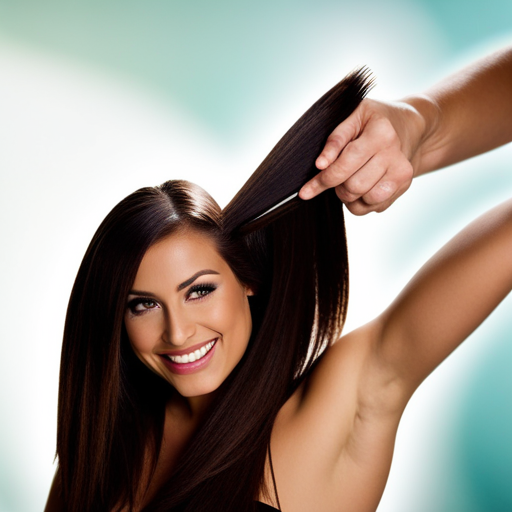Solving Common Issues With Hair Extensions and Wigs

Like a well-crafted masterpiece, hair extensions and wigs have the power to transform one’s appearance. However, common issues such as tangling, shedding, discomfort, and color matching can detract from the overall experience.
In this article, we will explore practical solutions to these challenges, providing valuable insights and tips to ensure a seamless and satisfying hair extension and wig experience.
Tackling Tangling Issues
To prevent and address tangling issues with hair extensions and wigs, regular maintenance and proper care are essential. Prevention strategies play a crucial role in minimizing tangling. One effective method is to brush the hair gently and regularly using a loop brush or a wide-tooth comb to prevent knots from forming. Additionally, braiding or tying up the hair before sleeping or engaging in physical activities can significantly reduce the risk of tangling.
When tangling does occur, employing the right untangling techniques is vital to prevent damage to the extensions or wigs. Using a detangling spray or conditioner can help loosen knots and make the hair more manageable. Start by gently separating the tangled strands with your fingers before using a brush or comb. It’s important to work through the tangles slowly and patiently, using short strokes to avoid putting too much stress on the hair.
Regularly inspecting the extensions or wigs for any signs of damage and addressing any tangling issues promptly can help maintain the quality and prolong the lifespan of the hairpieces. By incorporating these prevention strategies and untangling techniques into a regular maintenance routine, tangling problems can be effectively minimized.
Minimizing Shedding Problems
Effective maintenance and proper care are essential in minimizing shedding problems with hair extensions and wigs. To reduce shedding and prevent breakage, consider the following tips:
-
Gentle Detangling: Use a wide-tooth comb or a specialized brush designed for extensions and wigs. Start detangling from the ends and work your way up to the roots to minimize pulling and breakage.
-
Regular Conditioning: Keep your hair extensions and wigs hydrated and nourished by using a high-quality conditioner. Focus on the mid-lengths and ends, where dryness and damage are most likely to occur.
-
Avoiding Heat Damage: Limit the use of heat styling tools such as flat irons and curling wands. When heat styling is necessary, always use a heat protectant spray to minimize damage.
-
Secure Installation: Ensure that your hair extensions are properly installed and not too tight, as this can cause stress on the hair follicles and lead to shedding.
-
Careful Washing: When washing your extensions or wigs, use gentle, downward strokes to cleanse the hair without causing tangles or breakage.
Addressing Discomfort Concerns
When addressing discomfort concerns related to hair extensions and wigs, it is crucial to assess the fit and adjust the installation to alleviate any pressure or tension on the scalp. Scalp irritation can occur due to improper sizing, causing discomfort and even pain. Sizing adjustments, such as loosening or tightening the extensions or wig, can significantly reduce scalp irritation.
Furthermore, ensuring proper hairline blending and wig cap comfort is essential for a natural look and comfortable wear. Hairline blending techniques, such as tweezing or using concealer, can help create a seamless transition between natural hair and extensions or wigs. Additionally, choosing a wig cap made of breathable and lightweight materials can enhance comfort and reduce scalp irritation.
Transitioning to the next section about ‘dealing with color matching challenges,’ it is important to consider how discomfort may be compounded if the color of the hair extensions or wig does not match the natural hair. Color discrepancies can draw attention to the hair, leading to self-consciousness and discomfort for the wearer.
Dealing With Color Matching Challenges
How can color discrepancies in hair extensions or wigs exacerbate discomfort for the wearer?
Color matching challenges with hair extensions and wigs can significantly impact the wearer’s comfort and confidence. Customizing shades and utilizing blending techniques are crucial in addressing these challenges.
Here are some important considerations for dealing with color matching issues:
-
Undertone Matching: Matching the undertone of the hair extensions or wigs to the wearer’s natural hair is essential for achieving a seamless and natural look.
-
Custom Coloring: Offering custom coloring services can help in creating a perfect match for individuals with unique hair colors or tones.
-
Blending Techniques: Utilizing blending techniques such as balayage or ombre can help create a more natural transition between the natural hair and the extensions or wigs.
-
Color Swatching: Providing color swatching services can assist individuals in selecting the most suitable shade to match their natural hair color.
-
Professional Consultation: Offering professional consultations with experienced stylists can ensure that the color matching process is personalized and precise.
Handling Styling and Maintenance Tips
To ensure longevity and a polished appearance, proper styling and maintenance of hair extensions and wigs is essential. Incorporating the right styling techniques and maintenance routines can significantly prolong the lifespan of these hair accessories. Here are some tips to help maintain and style hair extensions and wigs effectively:
| Styling Techniques | Maintenance Routines |
|---|---|
| Use heat protectant before applying heat styling tools. | Detangle the hair gently using a wide-tooth comb or a specialized brush. |
| Avoid excessive heat exposure to prevent damage. | Wash the extensions or wigs regularly with sulfate-free shampoo and conditioner. |
| Experiment with different hairstyles to minimize stress on the extensions or wigs. | Store the extensions or wigs on a mannequin head to maintain their shape and prevent tangling. |
Frequently Asked Questions
How Do I Properly Store My Hair Extensions and Wigs When Not in Use?
Properly storing hair extensions and wigs when not in use is essential for maintaining their quality. To ensure longevity, store them in a cool, dry place, away from direct sunlight and heat sources. Regularly brush and detangle them to prevent matting.
Can Hair Extensions and Wigs Be Worn While Swimming or in the Shower?
When it comes to hair care and maintenance tips, it’s crucial to consider the impact of water exposure on hair extensions and wigs. While some options may be suitable for swimming or showering, proper care is essential.
What Is the Best Way to Protect My Hair Extensions and Wigs From Heat Damage?
To safeguard hair extensions and wigs from heat damage, it is essential to use heat protection products before styling. Additionally, opting for low heat settings on styling tools and minimizing heat exposure can help maintain their quality.
Are There Any Specific Products I Should Avoid When Caring for My Hair Extensions and Wigs?
When caring for hair extensions and wigs, it is crucial to avoid certain products that can cause damage. Maintenance tips include steering clear of alcohol-based products, excessive heat, and heavy oils to preserve the quality and longevity of the extensions and wigs.
How Do I Know When It’s Time to Replace My Hair Extensions or Wigs?
Signs of damage and a replacement timeline are vital factors in determining when to replace hair extensions and wigs. It’s necessary to watch for changes in texture, shedding, and overall wear and tear. Regular maintenance and inspection are key.
Conclusion
In conclusion, hair extensions and wigs can present various challenges, but with the right knowledge and techniques, these issues can be easily resolved.
By addressing tangling, shedding, discomfort, color matching, and styling concerns, individuals can enjoy the benefits of hair extensions and wigs without the common issues that may arise.
Remember, with a little TLC, these hair accessories can be a valuable and transformative addition to your beauty routine.





